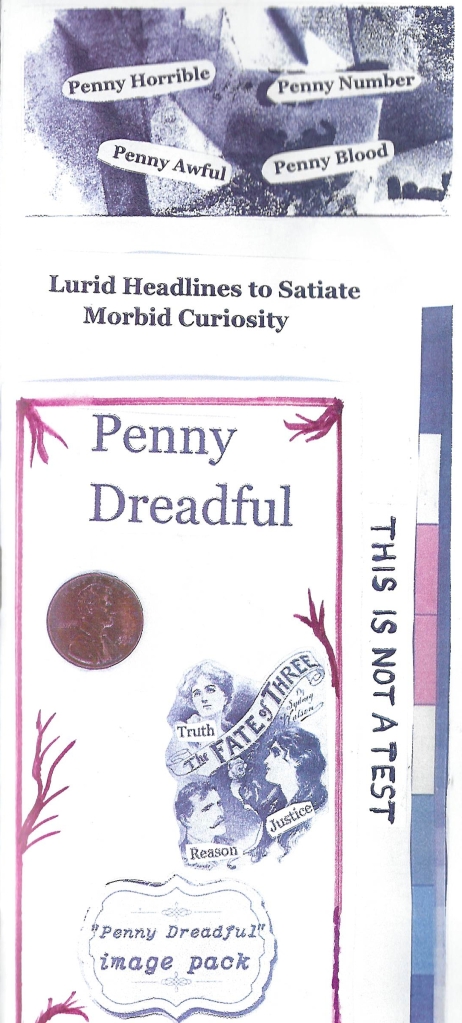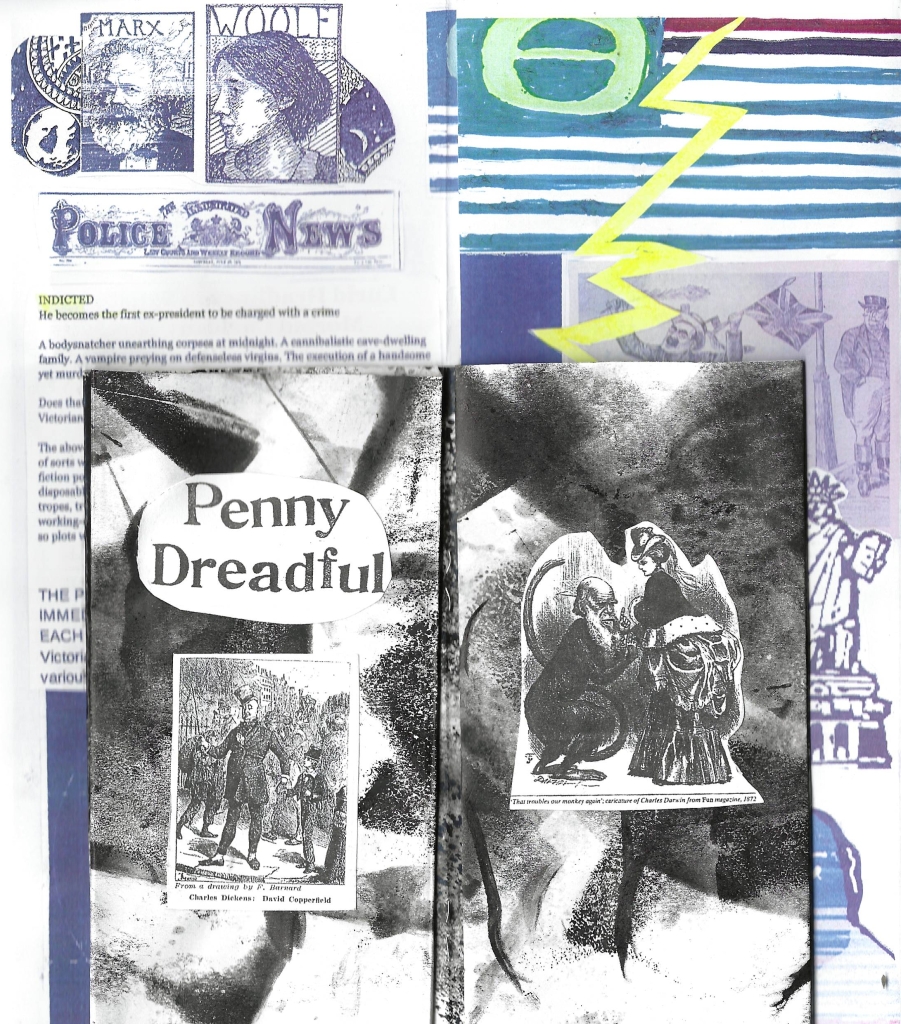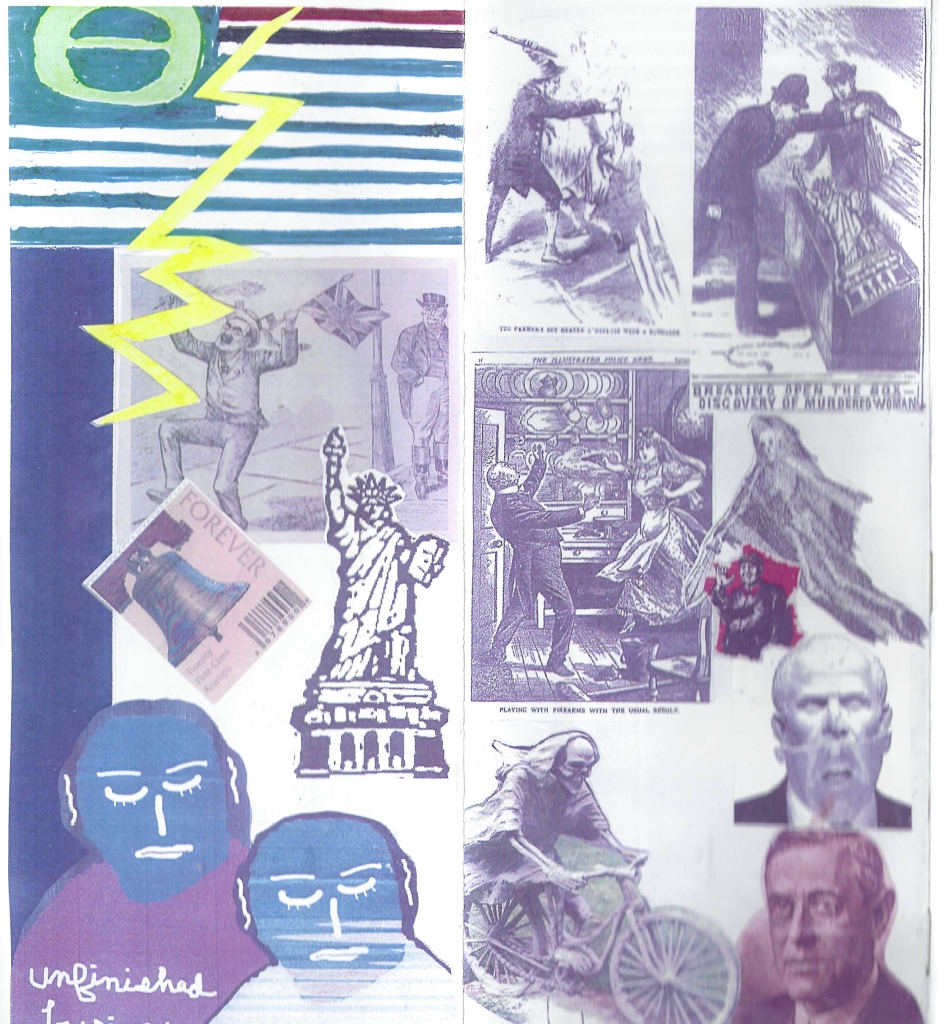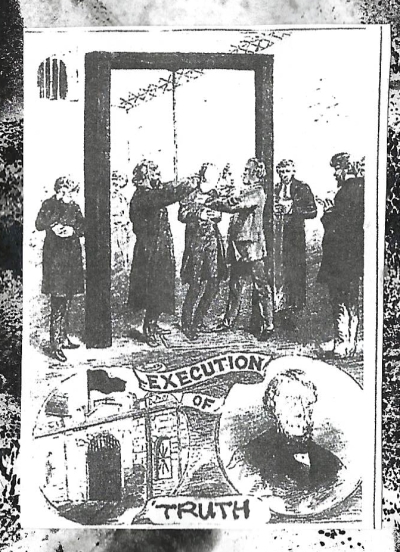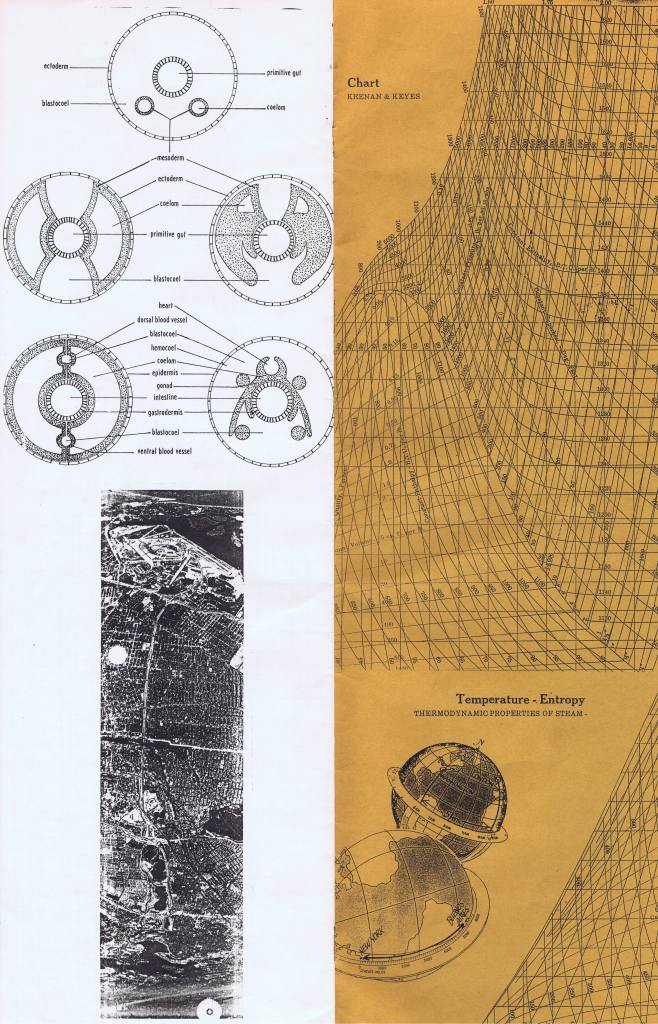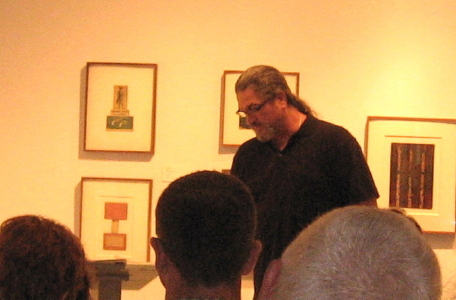PENNY DREADFUL an essay in small print
My latest and biggest ever mail art is out in the world in an edition of 120! Based on an early form of street literature I learned about from Dr. Charles Edge at UNC-CH in the early 70’s. I previously used the format in a self-publishing project with 6th graders at Glenwood Elementary my final year in Chapel Hill. Sent one year from an inauguration that will be a watershed for our country – one way or the other.
The format is a 2-sided color photocopy enclosing a small booklet made of an 11×17 sheet strategically used to clean off excess ink from the platen after letterpress printing nature book covers. I also used these for the zine version of my pandemic mail art piece, Plague Daze.
Historic images of Penny Dreadful covers and other historical print images (occasionally modified) were cut out and glued into the booklet. Over 3000 pieces! Not all are shown.
Throughout, the reproduced pencil drawings are my tracings and re-drawings of print images. Hilariously, the mounted penny is the specific reason this mailing is slightly too thick to qualify as first class by current (much stricter) regulations. Also, mounting the penny with glue on the back side is surely a defacement, which is a federal offense. I love the subversion but I fervently hope none get returned (109 are in the mails as I write).
A big thanks to contributors of images: David Larson, John Justice, Jonathan Laurer and of course the online resources for Penny Dreadfuls. This mailing was sent in the memory of Ray Johnson, correspondance artist extraordinaire. Richard C, Ray J’s curator, and John Justice received draft versions of the project which were essential in finalizing the final design. Mail art lives!
Our country and its democracy, such as it is, WILL survive – American history is filled with far worse episodes. Besides, the really big boys are not going to let our lucrative systems break down – and The System is inexorably getting more progressive and global all the time – but this has been a hell of a wake-up call for all of us. God bless us all.
Feedback on Penny Dreadful
Mary R: Shadow and light conjoined in a delightful dreadful death of democracy, a fine memento mori for Ray….. most grateful and amazed!
Alyssa S: It was such s surprise and delight to receive! I’m looking forward to spending more time with it. Each look, I catch something I didn’t see before.
Cheryl C T: There’s so much to see. Each time I look, I find another interesting detail.
Lee M C: I am really moved by this work..opening it and being..yes this is today and yesterday and the impending proverbial bad penny! amazing imagery , prophetic synchronicity
Eric N:Got my Penny Dreadful mail art a few days ago. Thank you so much–a remarkable assemblage. I love it
Marcia C: What a wonderful surprise to have your very cool little book arrive in the mail. Thank you so much! Penny Dreadful is a rouge book that has some wonderful fingerprints on it. I can see all your hand work and paste and stick and fold.
Jen C.: You have lit up my imagination once again, John.
Plague Daze Zine Features in Asheville Zine Fest Exchange
September 20th, 2020 marks the scheduled day for the Asheville Zine Fest, a long standing venue for the numerous micro-publishers in Asheville as well as zinsters across the state. The Paper Plant was set to participate, and I was very excited to network with other publishers and display the Paper Plant catalog at The Center for Craft in downtown Asheville. Alas, the event was cancelled but then replaced by a wonderful idea: a zine exchange among the publishers. That motivation pushed me to one last version of Plague Daze, the May 2020 mail art project that I also had converted to poster form for a mail art show at The Flood Gallery in Black Mountain. Above is the zine I created along with a spread of the zines I received in the exchange.
The packet I received contained a predictably wild variety of graphic designs and content. The organizers used the now-closed Asheville Bookworks as headquarters, and Laurie Corral, Jessica Smith and Mica Mead and Colin Sutherland of Woolly Press, a west Asheville publisher and risograph shop, worked to make this happen. I enjoyed all the entries, particularly Laurie’s risograph project “Forager’s Favorites,” and a wonderful textless mini-comic by Carrboro artist Julia Gootzeit called “B-Sides.”
I enjoyed all the entries and hope to meet many of the publishers in person at next year’s Zine Fest. A dominant theme in the collection above is risograph work, which was new to me until I discovered Woolly Press a while back. To quote the School of Design at the University of Illinois,
The Risograph is a stencil duplicator. Think of it as a cross
between screen printing and photocopying. The Riso prints
one color at a time in bright, vibrant colors. It is ideal for
posters, graphic prints, zines, comics, and other graphic arts.
Each color requires a separate print run. The colors are like strong watercolor tones, and I like the effect very much. Asheville is a hot scene for alternative arts, and zines and fine art printing are no exception! Below is a description of the rather laborious process used for my own contribution.
Plague Daze started as a mail art project sent out on May 1, 2020. Rubber stamping was the primary means of making images, with collaging of hand-laid paper some monoprinted and marbled. The poster version I created featured a collage and marbled version of the “40 days” concept from the mail art piece. That image, along with the art of guest artists, was color photocopied and then cut out and glued on to the background pages. Those pages are my secret ingredient for this zine. In printing covers for my book, The Natural History of Raleigh,” I set aside a ream of 11×17 copier paper to use in clean-up. The excess ink was removed with these, leaving strategic marks of the curved platen, the brayer marks, and various accidents of the cleaning motions. I collected over 200 of these and when the call for a zine came, I knew these were the perfect background for some pandemic content! Enjoy the contents of my zine below, and be safe!
Connie Bostic is a founder of the River Arts District in Asheville, and a leading figure in the Black Mountain College Museum community.
You may recall that Mary’s booklet, reproduced and stapled into the middle of the zine, was featured, along with the Anna Weaver poem below, in a post here. (full size scans).
Bonniediva is a mail artist with whom I came into contact through a national mail art organization.
Sure honored to have this set of zine publications for the Paper Plant archive of zines and other alternative art and publishing from the 1980’s.
Mail Art Response Provides Pandemic Panacea
We are extremely lucky, thus far at least, to be in our little mountain cove far from the hotspots during the trying times of Spring 2020. Just as the news got really bad, I was in the midst of mailing out a major project – Charts of the Universe 2020. Suddenly mail art seemed like a really good idea, and actually made the news, described as “a charming trend” on artnet.com. I got several nice responses to my Charts project, including some wonderful mail art pieces to add to my large collection.
Anna Podris created the image above as the centerpiece of her tri-fold mail art. Anna’s design responded directly to the Charts format, but I find the bird to be a perfect specimen of her own style, evoking her wonderful story-telling encaustics.
Orvokki Crosby sent a wonderful mail art folder created from what appears to be a long dust jacket with many labor intensive additions, all textured with meticulous marker highlights. She is a big fan of snail mail and, like myself and many others, hopes mail art remains viable (along with the Postal Service that allows it to exist!)
The mail art pictured at the top of the post features several postcards from Connie Bostic, a beloved Asheville artist and pillar of the BMC scene there, as well as John Justice, a new writer friend who says he is inspired by the mail art he has received. The “Quing” postcard is from Richard C, who curated the 1976 Ray Johnson mail art exhibit that got me started with mail art in the first place. Richard is going strong with mail art, and so am I. Maybe in the slightly new world in which we find ourselves, others too will see the value in this populist and irrepressible art form.
Charts of the Universe Culminates After 33 Years
Just completed Charts of the Universe 2020, a collage booklet in an edition of 36. Each one features an original collage, as seen above, with the following image recipe: a wildlife image, a cultural image, Jesus and a redemptive butterfly, a connective ribbon and two different brackets.I have been creating and sending correspondence art since discovering Ray Johnson and his show of mail art at the downtown NC Museum of Art in 1976. Ray responded to the zine I sent him and I was hooked for life.
This series, as with most, including a similar project entitled Science and Truth published soon after the Trump election, looks for resonances between art and science, between data-based visuals and visual aesthetics, locating surprising beauty in graphic information. The current project wraps up the Charts project for me, which began as an installation of assemblages at The Paper Plant bookstore which was accompanied by a chapbook of Chart images. Images of the chapbook are below.
The show of assemblages included over a dozen works, some designed for individual people and a few general ones. Like the final booklet I just mailed, the project was dedicated to Clyde Smith, who took me to that life-changing Ray Johnson show, and Richard C, the curator of that show, who became a friend and correspondent who still sends me his wry and quirky postcards.
Though I will continue to Chart in personal correspondences, this booklet marks the completion of the project and its group pieces. Send me your snail mail and I will add you to my mailing list. You will probably get a Ray J Jumps In, a memorial project that I hope will never end. Cheers to mail art!
Project Updates
Ray Johnson Show a Multiple Power Play
“to make open the eyes” Josef Albers All work of Ray Johnson on this site is used by permission of The Ray Johnson Estate
All work of Ray Johnson on this site is used by permission of The Ray Johnson Estate
BMC to NYC: The Tutelary Years of Ray Johnson (1943-1967)
Ray Johnson was probably the most enigmatic and least appreciated artist of his importance in the 20th century. He was a man of many many layers, not so much depth, on first impression, just layers, fairly random factors that underlie and overlay his work. The show just ended at The Black Mountain College Museum and Art Center had many layers itself, over multiple valuable events, and provided a greatly needed showcase and explication for this “seminal figure of Pop Art” whose collages “influenced a generation of contemporary artists.”
The show and especially its catalogue were already reviewed here, but several subsequent events have enriched the impact of the show. Dr. Francis F. L. Beatty (quoted and seen above), a curator who works with the Ray Johnson Estate, gave a lecture at the BMCM+AC on May 21, using parallel slides to show that Ray displays elements in his collages that link him to the major artistic trends of the day. His wit, humor and intense communications of all kinds were highly stimulating but hard to classify, but his collages and the palette he created out of found and encountered material can be seen as fully in the tradition of Klee’ as well as Albers, while partaking of the humor of Dada. “I don’t make pop art. I make chop art.” Ray’s statement refers to his use of old work in new, and Dr. Beatty skillfully elucidated the way in which Ray’s “chop art” (often meticulous geometric constructions) came right out of his Black Mountain experience. She makes a point that reverberated through this show: the liberation of American education happening at Black Mountain served as well to “liberate Ray Johnson.” He found himself, and he found the principle that best illuminates the breadth of his work for me: images standing in for words, words become imagery.
Yet Ray remains enigmatic. Dr. Beatty spent much time on the 55 Moticos – huge intricate collages – which Ray made and destroyed, calling them “some of the earliest and most significant examples of Pop Art.” She recounted many personal interactions with Ray, such as the time he approached her and finally wanted to do a gallery display – of “Nothings.” Beyond his inscrutability, his avoidance of the commercial process, Dr. Beatty makes a simple but important point – the small scale of Ray’s visual work limited his gallery prospects and indirectly his artistic stature.
The scale of Ray’s imagination and willingness to live his life for art was unbounded, of course. The final night of the show, orchestrated by curator Sebastian Matthews, was a truly wild and wonderful event that did much to reflect Ray’s spirit. Music, poetry, and spoken word all filled the space.
“We have to seize the things we need to create.” These words were spoken in Picasso’s voice by Keith Flynt, one of the closing night performers (seen below).
Earl Bragg, seen above, offered a nine-eleven poem that featured number names – worthy of Ray’s glyphs and puns. His political themes and passionate phrases made for an excellent reading.
Local dramatists staged a reading of a collaged piece incorporating Ray’s play inside a play about Ray discussing a play with pink James Dean.
The final word has to go to Sebastian Matthews, who did such a magnificent job not only of putting on the show but of staying in touch with Ray’s spirit the whole time. He evoked and nurtured the image of Ray as filled with humor, energy – and a total lack of any sense of propriety. About the “chop art” and “lost art” which was so prominent in the show, he says: “Ray loved to make things up, kill them off, and resurrect them.”
The Ray show is dead, long live the Ray show.
